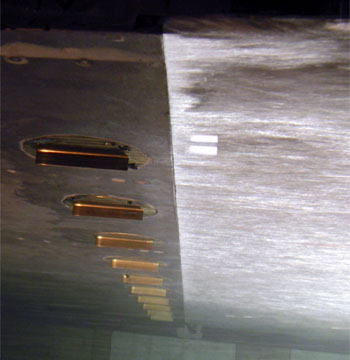Research: Turbulent Boundary Layers At High Reynolds Number
Sponsor: Defense Advanced Research Projects Agency, Office of Naval Research
Faculty Collaborators: Steven L. Ceccio, Marc Perlin
Turbulent boundary layer (TBL) skin friction is perhaps the lone phenomena limiting the speed, load carrying capacity, and operating range of commercial and military transport ships. Thus, an effective means to reduce TBL skin friction will have both economic and strategic or tactical importance. This project uses the world's largest water tunnel (The US Navy's William B. Morgan Large Cavitation Channel) and a 12.9-m-long flat plat test model to assess the effectiveness of TBL skin-friction reduction strategies that have been successful at lower Reynolds numbers. These experimental investigations currently include bubble and polymer injection into the TBL at downstream-distance-based Reynolds numbers greater than 200 million.

Selected References:
Sanders et al., JFM 552, 353-380 [2006]
Elbing et al., JFM 612, 201-236 [2008]
Winkel et al., JFM 621, 259-288 [2009]
Oweis et al., JFM 665 357-381 [2010].
Winkel et al., Exp. Thermal Fluid Sci. 40, 140-149 [2012].
Elbing et al., JFM 717, 484-513 [2013].
Elbing et al., Phys. Fluids 25, 085103 (13 pages) [2013].
Mäkiharju et al. JFM 732, 47-76. [2013].
Perlin, Dowling & Ceccio, ASME JFE 138, 091104 (16 pages) [2016].
Current Research Projects
1. Predictions of Acoustic Uncertainty
2. Blind Deconvolution in Reverberant Environments
3. Nonlinear Techniques for Remote Sensing
4. Acoustic Diagnostics for Reverberant Environments
Recent Research Projects
5. Acoustic Coherent Backscatter Enhancement
6. Simulations of Washing Machine Processes
7. Turbulent Boundary Layers At High Reynolds Number
8. Multi-dimensional Measurements of Velocity during Thermoplastic Injection Molding
9. Beyond Line-of-sight Acoustic Sensing
10. Measurements of Oil-film Thickness